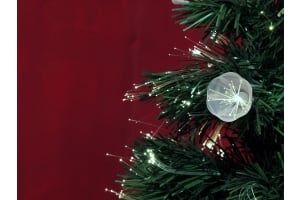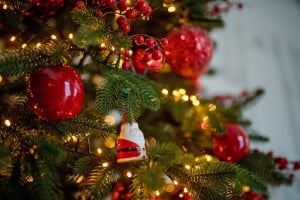The History of Christmas Trees
Today Christmas trees are an essential part of any traditional Christmas. They are a place to put presents, gather around and decorate as a family bonding experience. However, this was not always the case. Before artificial Christmas trees were a quintessential element of Christmas traditions, evergreen plants were used to provide some greenery during the winter months.
So how did the humble fir tree turn into the first Christmas tree, and why are Christmas trees now considered essential in many households?
Read on to learn more about the fascinating history of the Christmas tree and how it spread across the world!
What are the origins of Christmas trees?
Even though our modern-day Christmas trees are a relatively new invention, using trees in the home is not a new tradition. In fact, trees and plants that remain green throughout the year have always been special to humans, long before the rise of Christianity.
Ancient people used to hang evergreen branches in their windows and door frames, as it was believed to ward off evil spirits, ghosts, witches and winter illnesses.
Alongside this, trees were also used to help people through the winter months. In the north, the winter solstice is the shortest day and is celebrated on the 21st or 22nd of December.
Historically, people believed that our sun was a god in the sky. They blamed winter on an ailing, sick sun god. Winter solstice was celebrated because the days were becoming longer, meaning the sun god was starting to heal.
Evergreen plants were brought into homes during winter to remind the people that the sun god will become stronger and summer will come again.
However, there are some other origins of the Christmas tree which can show us where our favourite Christmas tradition has come from.
Ancient Egyptians
In Egypt, the Ancient Egyptians worshipped the sun god Ra. When it was the winter solstice, the Ancient Egyptians decorated their houses with green palms, which celebrated Ra's recovery from disease as well as life defeating death.
Romans
The Romans celebrated the winter solstice with a large feast named Saturnalia. This feast was to celebrate Saturn, the Roman God of agriculture. Saturn was celebrated because the Romans knew that soon their fields would again bear food. The feast decorations included hanging evergreen boughs in homes and places of worship.
Druids
The Druid priests in Europe decorated places of worship with evergreen boughs. This was to celebrate life eternal. Even the Vikings considered an evergreen tree to be the plant of Balder, their sun god.
Where did Christmas trees originate?
So, how did we move from evergreen boughs to having whole trees in our homes? Germany has been credited with starting the Christmas tree tradition and linking it to Christianity.
In the 16th century, Christians would bring a decorated tree, known as a paradise tree (to honour Adam and Eve), into their homes. If no fir trees were available, they would build wooden pyramids and decorate them with evergreen plants and candles to celebrate Christmas.
It is believed that Martin Luther was the first to decorate his tree branches with burning candles after being inspired by stars.
The rising popularity of Christmas trees in the UK
The popularity of Christmas trees in the UK has been on quite a journey!
The tradition of owning a Christmas tree during the festive period in Britain can be said to have originated when Queen Victoria and her German husband, Prince Albert, were sketched owning one. Upon the tree, they hung small presents, and their children surrounded them. The sketch was featured in the Illustrated London News.
After WWI, Christmas trees took a dip in popularity in the UK due to anti-German sentiment. But, from around the middle of the 1920s, the Christmas tree began to rise in popularity once again.
In 1933, Christmas tree production became commercially viable for the first time in Britain. So, no need to import foreign Christmas trees!
Nowadays, the Christmas tree in Britain is more popular than ever. Over 8 million homes are decorated with green bushy Christmas trees during the festive season, as well as many shops and public spaces opting to do the same.
Decorations and size
During Victorian times, Christmas trees were decorated with candles. This was to remind people of the stars that shone in the sky during the time of the birth of Jesus. However, using candles was logically a very dangerous fire hazard. So, nowadays, little colourful LEDs are used instead.
Also adorned upon Christmas trees were sweets and cakes hung with ribbon. In 1880, Christmas tree decorations began to commercialise, with Woolworths selling its first manufactured Christmas tree ornament.
Nowadays, Christmas trees are popularly decorated with tinsel, small colour lights, and small ornaments. Presents are now commonly placed under the tree, rather than balanced upon the branches!
Why do we decorate Christmas trees?
Decorating Christmas trees became popular after the image of Queen Victoria with a decorated tree circulated. Prior to this, Christmas trees were decorated with homemade and natural elements, but suddenly there was a demand for ornate Christmas tree decorations.
Christmas baubles, a popular tree decoration, can be traced back to the town of Lauscha, Germany. In the 1800s, glassblowers in Lauscha started producing detailed glass ornaments that could be hung on trees. These baubles grew in popularity and were taken to America by F.W. Woolworth and then around the world.
Christmas tree lights
Lighted candles in trees are attributed to Martin Luther, who wanted to bring the night sky into his home. These days people use Christmas tree lights on their trees as they produce a safe and warming glow.
The rise of artificial Christmas trees
TIME Magazine changed the realm of Christmas trees in 1964 when they published an article on the next big festive season trend: artificial Christmas trees.
These trees look incredibly realistic and are a fantastic alternative for people who wanted to celebrate Christmas without having to worry about dropping pine needles or disposing of a real tree. More than 60 years later, artificial trees are still dominating the Christmas tree business.
There are plenty of reasons why artificial Christmas trees remain popular today:
- Changes in local climates have made it more difficult to grow trees.
- Artificial Christmas trees can be reused each year and save you money.
- Fewer trees were planted during the recession, and with an average growth of 7 to 10 years before use as a Christmas decoration, the effects are still being felt today.
- An artificial Christmas tree is considered to have a lower environmental impact, even when considering manufacturing and transportation environmental costs.
Christmas trees across the globe
Below is a brief glimpse into the history and popularity of the Christmas tree in different countries around the world.
Brazil
Despite Brazil enjoying a summer Christmas, pine trees are sometimes decorated with cotton to represent snow on the branches. Other traditional ornaments are also used.
Canada
The Christmas tree was brought to Canada in the 1700s by German settlers who migrated from the United States. When the Windsor Castle Christmas tree and Christmas lights were seen around the world in 1848, the Christmas tree became traditional in Canada.
Greenland
As no trees grow as far north as Greenland, Christmas trees are imported to the country each year. People in Greenland put up a tree decorated with colourful ornaments and candles.
Guatemala
There are a lot of Germans in Guatemala, which has resulted in the inclusion of the Christmas tree as part of the nativity scene. Many people set up a modern Christmas tree in their homes, and gifts are placed under the tree for the children. Notably, adults do not have a Christmas gift exchange until the New Year.
Ireland
In Ireland, real trees are often placed in homes during December. These trees are decorated with coloured LED tree lights, lots of tinsel, and glass baubles. The rest of the home is also decorated with plants, lights and candles. Mistletoe, garlands and wreaths decorate door frames and the front door.
Italy
Many homes in Italy do not have a traditional Christmas tree. Instead, they make use of a ceppo, which is a pyramid structure made from wood. The ceppo has several shelves and is decorated with pine cones, paper and pennants. Lighted candles adorn the sides and a star or figurine hangs from the top of the pyramid. The base of the ceppo depicts the nativity scene.
Ceppos are part of the Tree of Light tradition, which resulted in the rise of the conventional Christmas tree in other countries.
Mexico
Pine trees are not common in Mexico, so many Mexican families invest in a small artificial tree called an arbolito. Others would use a single branch from the copal tree or decorate local shrubs found in the surrounding countryside as their arbolito.
The nativity scene is the main festive decoration; however, sometimes, the arbolito is incorporated into the scene.
Norway
Many Norwegians will go on an outing to the local woods to pick wild evergreen trees to be used as the centre of the Christmas decorations. This is a relatively new tradition, as the decorated Christmas tree was only introduced to Norway late in the 19th century.
Christmas trees are usually decorated by parents on Christmas Eve and then revealed to the children. The family will hold hands and sing around the tree, and gifts will be exchanged.
Spain
Christmas trees look a bit different in Spain, especially in Catalonia, where the Tio de Nadal (translated as "pooping log") is popular with families.
An empty tree trunk will be "fed" treats like nuts and sweets leading up to Christmas. Kids will even cover the log with a blanket at night. When Christmas Eve comes around, children will take turns hitting the trunk and trying to spill the treats.
Ukraine
In Ukraine, Christmas is celebrated on 25 December by the Catholics and 7 January by the Orthodox Christians. During Christmas in Ukraine, you will find a fir tree decorated with ornaments in many homes.
When should you put up your Christmas tree?
Traditionally, a Christmas tree is put up at the beginning of advent. Advent is the fourth Sunday before Christmas day. Although this is the most common rule, a lot of people put up their Christmas trees on the first day of December.
There is no right or wrong date - you should put up your tree when you have the time and are feeling festive!
When should you take down your Christmas tree?
Again, there is no right or wrong date for when to take down your Christmas tree. A lot of people take their trees down by 1 January. Christian traditions explain that Christmas ends on the Twelfth Night, which is the Eve of Epiphany, and that is when you should be taking down your tree.
Find the perfect Christmas tree for your home
Christmas trees have a rich history and have become a symbol of Christmas despite having roots in what were believed to be pagan traditions.
No matter your faith or which country you find yourself in, it is no doubt that the Christmas tree is here to stay for many years more! So if you are interested in getting your own artificial Christmas tree or Christmas decorations, explore the Christmas Tree World website for ideas and inspiration.






